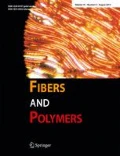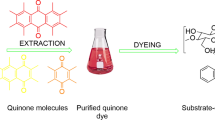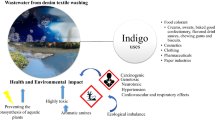Abstract
In this work, the substitution of environmentally harmful additives in the industrial dyeing process of polyamide-6 microfiber-made knitted fabrics (PA-6µFKF) was studied. Using the disperse red 60 (DR60) dye, kinetic adsorption tests on the PA-6µFKF dyeing were performed by using either β-cyclodextrin (β-CD) additive, commercial leveling agents, or without additives. Equilibrium tests were also performed during 25 h. A modelling based on a dye adsorption process controlled by an intraparticle diffusion was proposed to represent the sets of kinetic data. Three isotherm models were also tested for representing the equilibrium data. The kinetic data have evidenced three main dye diffusion zones. Different adsorption mechanisms on PA-6µFKF surface dyeing was evidenced, being the data well represented by the two-step Langmuir isotherm. Finally, the best quality on color uniformity was attained using the β-CD additive, revealing a good alternative for the substitution of environmentally harmful additives in industrial dyeing processes.
Similar content being viewed by others
References
S. Xu, J. Chen, B. Wang, and Y. Yang, J. Cleaner Prod., 112, 987 (2016).
M. A. Tavanaie, A. M. Shoushtari, and F. Goharpey, J. Cleaner Prod., 18, 1866 (2010).
B. Voncina in “Textile Dyeing” (P. J. Hauser Ed.), pp.372–392, InTech Books and Journals, 2011.
B. Voncina and V. Vivod in “Eco-Friendly Textile Dyeing and Finishing” (M. Gunay Ed.), pp.53-75, InTech, 2013.
A. Cireli and B. Yurdakul, J. Appl. Polym. Sci., 100, 208 (2006).
E. B. P. Savarino, S. Parlati, R. Buscaino, P. Piccinini, and I. Degani, Dyes Pigm., 60, 223 (2004).
B. Vončina, V. Vivod, and D. Jaušovec, Dyes Pigm., 74, 642 (2007).
E. Bakan, F. Karcı, and O. Avinc, Fiber. Polym., 19, 670 (2018).
O. J. Otutu and A. K. Asiagwu, J. Sci. Res., 11, 215 (2019).
S. Parlati, R. Gobetto, C. Barolo, A. Arrais, R. Buscaino, C. Medana, and P. Savarino, J. Inclusion Phenom. Macrocyclic Chem., 57, 463 (2007).
A. R. Hedges, Chem. Rev., 98, 2035 (1998).
A. D. Broadbent, “Basic Principles of Textile Coloration”, Society of Dyers and Colourists, 2001.
J. G. Grundy, J. Soc. Dyers Colour., 60, 205 (1944).
S. M. Burkinshaw, “Physico-Chemical Aspects of Textile Coloration”, John Wiley & Sons, 2016.
A. Ebadi, J. S. Soltan Mohammadzadeh, and A. Khudiev, Adsorption, 15, 65 (2009).
L. N. Konda, I. Czinkota, G. Füleky, and G. Morovján, J. Agric. Food Chem., 50, 7326 (2002).
I. Czinkota, R. Földényi, Z. Lengyel, and A. Marton, Chemosphere, 48, 725 (2002).
V. M. Esquerdo, T. R. S. C. Jr, G. L. Dotto, and L. A. A. Pinto, J. Colloid Interface Sci., 424, 7 (2014).
N. Rabiei, M. H. Kish, S. H. Amirshahi, and M. Radjabian, Dyes Pigm., 94, 386 (2012).
S. A. Holmes and S. H. Zeronian, J. Appl. Polym. Sci., 55, 1573 (1995).
K. Gharanjig, F. S. Dadras, M. Sadeghi-Kiakhani, and S. Tafaghodi, J. Dispersion Sci. Technol., 34, 381 (2013).
K. H. Park, M. Casetta, and V. Koncar, Color. Technol., 118, 319 (2002).
C. Makhlouf, C. Kacem, S. Roudesli, and F. Sakli, J. Appl. Sci., 8, 77 (2008).
W. J. Weber and J. C. Morris, J. Sanit. Eng. Div., Am. Soc. Civ. Eng., 89, 31 (1963).
J. Odvárka and J. Huňková, J. Soc. Dyers Colour., 99, 207 (1983).
H. M. Dardeer, A. A. El-sisi, A. A. Emam, and N. M. Hilal, Int. J. Text. Sci., 6, 79 (2017).
Acknowledgments
The authors thank to the Coordination for the Improvement of Higher Education Personnel (CAPES) for the financial support.
Author information
Authors and Affiliations
Corresponding author
Rights and permissions
About this article
Cite this article
Ferreira, B.T.M., Espinoza-Quiñones, F.R., Borba, C.E. et al. Use of the β-Cyclodextrin Additive as a Good Alternative for the Substitution of Environmentally Harmful Additives in Industrial Dyeing Processes. Fibers Polym 21, 1266–1274 (2020). https://doi.org/10.1007/s12221-020-9327-8
Received:
Revised:
Accepted:
Published:
Issue Date:
DOI: https://doi.org/10.1007/s12221-020-9327-8




